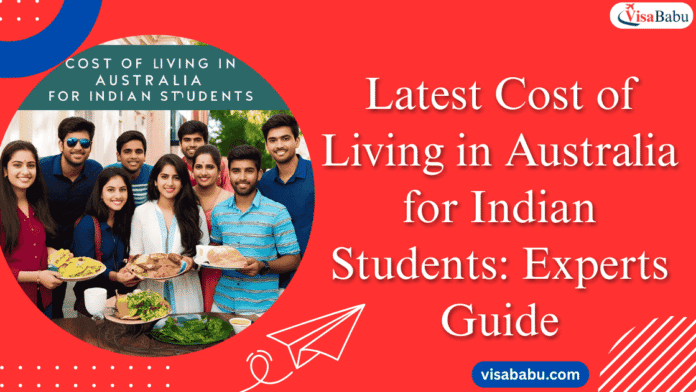The cost of living in Australia for Indian students represents a significant financial consideration when planning education abroad. Students need to consider a wide range of expenditures, from AUD 3,000 to AUD 6,000 per month, when planning their budgets for living and studying in Australia. This guide covers the most important expenses that Indian students should be aware of when studying in Australia in 2025.
Many Indian students still choose to study in Australia despite the higher living expenses compared to what they are used to in their home country. Australia offers first-class education, enticing post-study career prospects, and a diverse cultural setting, but having the right finances is key to a rewarding study journey.
Latest Facts About Cost of Living in Australia for Indian Students (2025)
Changes in the financial environment for Indian students studying in Australia became apparent in 2025. These are the most up-to-date details about what Indian students can expect to spend each month.
- The average monthly cost of living in Australia for Indian students is approximately AUD 5,000-6,000 if living alone
- Canberra currently has the highest monthly cost of living for an international student living alone (AUD 4,310), while Darwin is the most affordable city (AUD 3,486).
- Indian students may spend up to AUD 400 (INR 22,000) per month on their food and grocery expenses.
- The cost of living in Australia is approximately double that in India (excluding rent).
- Indian students are faced with rent costs that are 5.4 times higher in Australia than in India.
- A single public transportation monthly pass can easily set students back several thousand rupees.
- International students must provide evidence of sufficient funds equaling AUD 29,710 to the Australian government for entry approval.
Breaking down the individual costs and finding ways to save money can help Indian students realize the opportunity to study in Australia.
Understanding the Cost of Living in Australia for Indian Students 2025
The cost of living in Australia for Indian students varies significantly depending on location, accommodation type, and lifestyle choices. This financial demand is much larger than what Indian students would face in their home country.
Metropolitan cities such as Sydney and Melbourne tend to have higher living costs than regional areas. Indian students should plan to spend between AUD 3,000 to AUD 6,000 each month on combined expenses such as housing, meals, commuting, and utilities.
Students from India are often surprised by the higher cost of living in Australia. Nonetheless, being thorough with financial planning allows Indian students to meet these expenses. Most universities in Australia offer online tools and support to help overseas students estimate and manage their expenses.
While the cost of living in Australia is higher, the overall standard of living is very high compared to many other countries. Working part-time during studies allows students to cover some of their expenses and gain experience in an Australian environment.
A Detailed Analysis of Living Costs in Australian Cities 2025
Australian cities are ranked from most to least expensive for students.
The cost of living in Australia for Indian students varies dramatically across Australian cities. They are organized in order from the most costly to the least expensive.
| Australian City | Monthly Cost (AUD) | Monthly Cost (INR) |
| Canberra | 4,310 | ₹2,44,593 |
| Sydney | 3,982 | ₹2,25,979 |
| Melbourne | 3,778 | ₹2,14,402 |
| Perth | 3,774 | ₹2,14,175 |
| Brisbane | 3,726 | ₹2,11,451 |
| Hobart | 3,614 | ₹2,05,095 |
| Adelaide | 3,502 | ₹1,98,739 |
| Darwin | 3,486 | ₹1,97,831 |
Canberra holds the number one spot for the highest cost of living, and Darwin is the most economical city on the list. Students from India have the flexibility to select the city that best fits their finances.
Studying in Sydney and Melbourne may be slightly pricier, but they provide better job prospects and are home to bigger Indian populations, allowing for easy social integration. Studying in regional cities such as Adelaide and Darwin tends to be cheaper but could limit employment options while providing opportunities for permanent residency through regional study programs.
Indian students should carefully consider both the cost of living and the availability of courses, connections, and future career prospects before choosing a city in Australia.
Choosing Accommodation and Understanding Its Expenses for Indian Students in 2025
Different Accommodation Options and Their Monthly Rentals
Indian students in Australia spend the highest percentage of their budget on rent. Below is a breakdown of the average rents for several types of accommodation.
| Accommodation Type | Cost Range (AUD) | Cost Range (INR) |
| Homestays | 450-1,200 | ₹25,000-67,000 |
| Halls of residence | 440-1,100 | ₹24,500-61,200 |
| Private Apartment | 750-1,700 | ₹42,000-95,000 |
| Shared Apartment | 650-950 | ₹36,000-53,000 |
University halls and sharing a house with others are generally the most affordable options for Indian students. Amounts payable for rent often vary considerably depending on the specific neighborhood and whether it is in a city or suburban area.
The majority of Indian students usually seek out short-term accommodation first and then look for a more long-term settlement later. Colleges and universities regularly help students find appropriate accommodations and explain rental contracts.
Persistent gaps in gender equality, accessible housing, tackling addiction, providing social security, and promoting improved mental health prevent Canada from meeting all standards set forth in the Global Health Security Index. Some types of accommodation include utilities in the monthly rent, while others require rent and utility payments to be kept separate.
Students who want to save money could consider living in the suburbs, accessible via reliable public transport routes to their university. Some universities have special records of off-campus housing tailored to international students.
The Average Cost Of Food And Grocery Items In Australia 2025
Grocery prices in Australia may be unfamiliar to Indian students as they are much higher compared to the prices in India. Average monthly food and grocery expenses are between AUD 208 and AUD 416, or INR 11,000 to INR 22,000.
Australian grocery prices are 218.6% more expensive than in India. For example:
- A simple restaurant meal costs AUD 25 (INR 1,376) while in India, the same dish is only INR 250.
- A loaf of bread is priced around AUD 3.42 (INR 188) in Australia or INR 39 in India
- Prices for fresh fruits and vegetables are often between three and six times higher in Australia than in India.
Students find that cooking at home helps them save money, as eating out can be expensive. You can save a lot of money on groceries by shopping at Aldi instead of Woolworths or Coles. You can find cheaper fresh produce by shopping at weekend markets.
Indian ingredients are available at ethnic grocery stores in Australian cities, albeit at higher costs. Preparing easy meals in advance can help Indian students keep food costs under control.
Students often have access to microwaves and common rooms on campus, allowing them to save money by eating the meals they prepare at home. There are also plenty of student housing complexes with communal kitchens, making it easy for students to cook for themselves.
Travel Expenses Incurred by Indian Students in Australia 2025

Most Indian students in Australia use public transportation to get around. Both monthly and daily travel cards are considerably pricier compared to the rates in India.
Transportation costs vary by city:
- Australia’s largest cities have extensive but somewhat pricey public transportation networks.
- Students on a budget often prefer to live in Brisbane or Adelaide.
- Several institutions offer discounted buses of university shuttles.
Many students choose to cycle or walk to reduce their transportation expenses. Purchasing a student concession card is a wise decision for Indian students because they usually save around half the cost of public transportation in most cities.
Uber and Ola are options, but they can be expensive, so they should only be used for rare trips. When taking longer trips around the country, Greyhound Australia provides discounted fares for students.
The relative locations of your accommodation and both the closest public transport routes and your university campus are important factors that can save both time and money when it comes to getting around. Certain universities are near places with great cycling routes, allowing students to choose a bike for both convenience and cost savings.
Utilities and Communication Expenses in Australia in 2025
The average monthly cost for utilities such as electricity, heating, water, and garbage disposal is AUD 273 (INR 15,017). This amounts to approximately four and a half times the cost in India.
The average price for a mobile plan with unlimited calls and over 10GB of data is around AUD 41 (INR 2,273), and most internet plans with speeds of 60 Mbps or higher are priced at AUD 82 (INR 4,499).
Many Indian students save money by:
- Many students cut their living costs by sharing flats to share the expense of utilities.
- Connecting to the university’s Wi-Fi rather than paying for home internet.
- Opting for prepaid SIMs that include student benefits and features is recommended.
Affordable mobile services tailored to students are provided by providers such as Amaysim, Boost, and Kogan. Most universities have free Wi-Fi available on campus, and numerous public areas in Australian cities can be accessed with free internet.
Prices for energy tend to rise in the colder months in the south and hotter seasons in the north because households require more heating or cooling. Managing how you use home appliances and paying attention to energy use can help you keep your utility expenditures down.
Communication with loved ones in India can be done using apps such as WhatsApp, Zoom, and Skype, which provide affordable or even complimentary international communication features.
International Indian Students In Australia Must Pay For Healthcare And Insurance Expenses While Studying In The Country
All international students studying in Australia are legally required to have Overseas Student Health Cover (OSHC). The price can vary between AUD 500 and AUD 700, depending on the insurance company and the plan.
Some common medical costs you should be aware of are:
- Dental care is generally not included in the minimum OSHC coverage.
- Prescription medications
- Specialist consultations
Many colleges and universities provide healthcare services to students at discounted prices. Make sure you know the specific details of your OSHC plan and what out-of-pocket costs you may have for medical care.
Certain OSHC companies provide plans designed for Indian students that cover the most common medical needs. Looking at multiple OSHC providers before leaving for Australia will enable you to get comprehensive insurance at an affordable price.
Making smart lifestyle choices and keeping up with routine health screenings can help limit the necessity for medical care. Many universities provide students with access to gyms and health and wellness programs at no cost or at a reduced rate.
Education and Study-Related Expenses in Australia for Students 2025
Indian students also incur other expenses connected to their studies.
| Expense Category | Approximate Annual Cost (AUD) |
| Textbooks and supplies | 500-1,000 |
| Technology (laptop, software) | 1,000-2,000 |
| Library fees and printing | 100-300 |
| Professional memberships | 50-200 |
Students can save money by taking advantage of second-hand bookstores, equipment loans, and free software on campus. Most university libraries have multiple editions of essential texts available for loan, helping students save money on purchasing them.
Electronic textbooks are usually less expensive than hard copies, and certain teachers make study resources available without charging extra fees. Many universities form partnerships with tech companies to offer students access to discounts on software and hardware.
Most universities provide tutoring and writing assistance as part of tuition and help students achieve their academic goals at no extra expense. Many universities provide opportunities for students to participate in career-enhancing workshops and networking functions at no extra charge.
Indian Students Also Need To Consider Their Entertainment And Lifestyle Expenses
Participating in social activities and having fun are crucial parts of being a student. Students can expect to spend anywhere from AUD 118 to AUD 223 every month (approximately INR 6,500 to INR 12,000).
Common entertainment costs include:
- Cinema tickets: AUD 22 (INR 1,211)
- Fitness club membership: AUD 73 (INR 4,024) monthly
- Restaurant meals: AUD 25-120 depending on the establishment
Most universities in Australia provide a range of free or low-cost activities, clubs, and amenities that allow students to enjoy various forms of entertainment at an affordable price. Student unions often host a variety of cultural events, film screenings, and sports events at no or low cost.
Exploring Australia’s stunning natural attractions, such as beaches, national parks, and hiking trails, can be accessed at little or no expense. Many museums and cultural institutions have free or discounted entry for students.
Linking up with Indian organizations and groups in your local area will enable you to participate in events and activities that are enjoyable, culturally enriching, and budget-friendly.
Cost Comparison Between Australia’s Major Cities And Regional/Suburban Areas in 2025
Students can benefit greatly from the lower living expenses that are common in regional areas of Australia.
| Expense | Metropolitan (AUD) | Regional/Suburban (AUD) |
| Rent | 540 (INR 29,700) | 250 (INR 13,700) |
| Food & groceries | 151 (INR 8,300) | 137 (INR 7,550) |
| Utilities | 80 (INR 4,400) | 67 (INR 3,600) |
| Transportation | 38.46 (INR 2,095) | 25 (INR 1,300) |
Cost of living in Australian regional areas is typically 30-40% lower than in big cities. Furthermore, studying in regional areas can increase your chances of obtaining permanent residency in the country.
Many regional universities in Australia provide lower tuition costs and special scholarships for international students looking to study away from large cities. The Australian government promotes studying at regional universities by offering several incentives to international students.
In regional areas, there may be fewer job openings, but those that are available may have lower competition among applicants. The slower pace of life and strong sense of community often make regional areas welcoming and friendly places for international students to live.
Regional areas have their own authentic Australian flavors and closer proximity to stunning natural sites, offering a different and worthwhile cultural exchange for students.
Working While Studying in Australia: Supplementing Your Budget 2025
Students in Australia can work part-time for up to 48 hours per fortnight during the semester and can work as many hours as they wish during holidays. A student who works 16 hours per week at the minimum wage in Australia can expect to earn between AUD 1,000 and AUD 1,500 each month.
Common student jobs include:
- Retail and hospitality positions
- Campus jobs (library, administration)
- Tutoring and research assistance
- Rideshare and food delivery services
Part-time work helps students meet their expenses and gain valuable skills in the process. Most Australian universities offer career centers with resources to help students secure part-time jobs and understand their work entitlements.
Having relevant work experience, such as customer service or hospitality, can improve job prospects for Indian students. Volunteering or completing internships helps build a network of local contacts, which could lead to better employment opportunities.
You should manage your time well so that your work and studies don’t conflict. Some courses include placement experiences that satisfy both work and academic requirements.
Ways Indian Students in Australia Can Reduce Their Expenses in 2025
Expert Tips for Lowering Your Living Expenses
Applying these strategies allows Indian students to cut down on their living costs significantly:
- Accommodation: Consider living with a host family or sharing accommodation to save income.
- Food: Try to prepare most meals yourself, purchase groceries when prices are low and shop at markets towards the end of the day to get discounted rates.
- Transportation: Look into obtaining a student ID and using a bicycle whenever possible.
- Utilities: Be conscious of how much energy you use and consider sharing an internet plan with your housemates.
- Education: Look for used textbooks and make the most of what your university offers.
- Entertainment: Join in the various free activities and discounts organized by your university.
The majority of the universities provide financial aid and emergency loans to international students facing financial challenges. Student unions sometimes organize affordable meals and events where students can eat together to save money on food.
Students should remember to use their student ID whenever eligible for discounts. It pays to enquire about student-specific deals before buying anything. Many stores, businesses, and entertainment establishments provide student discounts that are often not publicized.
Establishing connections with fellow Indian students can help open up chances for splitting costs, such as cooking meals together or arranging to share transportation for shopping. Many online platforms and forums created by Indian student groups in Australia regularly update each other about cost-effective ways to live in their city.
Latest Cost of Living Comparison: Australia vs. India 2025
The cost of living in Australia for Indian students represents a substantial increase compared to expenses in India. In every category, the costs in Australia are much higher than in India.
| Expense Category | The percentage is Higher in Australia |
| Overall Cost of Living (excluding rent) | 224.1% |
| Rent | 547.5% |
| Restaurant Prices | 269.6% |
| Groceries | 218.6% |
| Transportation | 725.8% (one-way ticket) |
| Utilities | 328.3% |
Even though expenses are much higher, Indian students in Australia have 74.6% more buying power than at home due to the higher wages and general improvement in living standards. The higher minimum wage in Australia partially compensates for the higher cost of living when students have part-time jobs during their studies.
Australia’s better standards of infrastructure, public services, healthcare, and education come with correspondingly higher living expenses. Many Indian students consider the improved quality of life and education to be well worth the increased cost.
It is essential to be aware of these cost differences when setting a budget for studying in Australia. Indian students should also get ready emotionally for the increase in expenses they will face.
Preparing a Budget for an Indian Student’s Life in Australia: Experts’ Guide 2025
Creating a Realistic Financial Plan
A well-structured budget should account for all relevant costs, such as:
- Pre-departure costs: You must pay for a visa, your flight to Australia, OSHC, and a deposit for your first-month accommodation.
- Tuition fees: The cost of tuition varies between AUD 20,000 and AUD 50,000 each year, depending on the chosen course and university.
- Living expenses: Accommodation, food, transportation, utilities
- Emergency fund: A minimum of AUD 3,000 should be set aside for possible unforeseen costs.
Using budget templates and online cost estimators from universities will provide better budgeting insight. Many universities ask applicants to show that they have AUD 29,710 available each year (after direct costs) to support their visa application.
Keeping a monthly budget spreadsheet allows you to monitor and control your spending. Lots of financial institutions provide student accounts with lower charges and mobile apps designed to monitor expenditure.
Students should ensure they have enough money to support themselves for the first few months after arriving in Australia. Learning about currency exchange rates and how to send money cheaply from India to Australia is essential for keeping track of finances while studying in Australia.
Students from India often experience higher living expenses in the initial months of study because of the one-time costs involved. Having extra funds in your budget at the beginning of your time in Australia can make it easier to handle your expenses during the first few months.
Conclusion: Is the High Cost of Studying in Australia Justifiable for Indian Students?
Despite the high cost of living in Australia for Indian students, studying in Australia offers significant benefits, including world-class education, post-study work opportunities, and potential pathways to permanent residency. The higher costs are usually balanced out by the increased earning capacity available to students both during their studies and in the years following graduation.
Students can save money and still make the most of their time in Australia by creating a budget, selecting more affordable areas to live in, and applying wise money management techniques. Acquiring these skills, qualifications, and international experience tends to open up more opportunities and higher incomes later in life.
In addition to gaining valuable education, students also enjoy the cultural immersion, enhanced ability to communicate in English, and connections with people from all over the world. Many Indian graduates of Australian universities have found that their Australian education translated into significant benefits in their subsequent careers.
Students can make studying in Australia more affordable by researching scholarships, looking into regional universities, and creating a detailed budget. Preparing accordingly and keeping your goals in mind can make an Australian education a worthwhile investment for your career.
Frequently Asked Questions
Q1. An Indian student in Australia requires an average of AUD 4,000 to AUD 5,000 per month to cover their living expenses.
Ans. The monthly expenses for an Indian student in Australia range from AUD 3,000 to 6,000 Australian dollars, depending on the city and lifestyle. This encompasses costs for housing, meals, getting around, and various necessities.
Q2. Adelaide and Darwin are the most budget-friendly cities in Australia for Indian students.
Ans. Indian students will find living in Darwin and Adelaide to be the least expensive among major Australian cities, with average monthly costs of AUD 3,486 and AUD 3,502.
Q3. It is possible for Indian students to earn enough money through part-time work to help support their living expenses in Australia.
Ans. Earning money through part-time work can help reduce expenses, but it can only able to contribute to 30-50% of a student’s overall budget. Part-time employment cannot meet all the requirements of studying and living in Australia.
Q4.Indian students should set aside between AUD 208 and AUD 416 (INR 11,000 and INR 22,000) per month for food and groceries in Australia.
Ans. Indians studying in Australia are advised to set aside between AUD 208 and AUD 416 (INR 11,000 and INR 22,000) every month for food and grocery expenses.
Q5. Australian students may find living on campus or off-campus to be affordable options.
Ans. Rooms in halls of residence on campus generally charge between AUD 440 and AUD 1,100 each month, whereas shared apartments off-campus have rents that vary from AUD 650 to AUD 950. Many on-campus living arrangements cover utilities and internet in the rent, which can make them a value-for-money option compared to living off campus.









